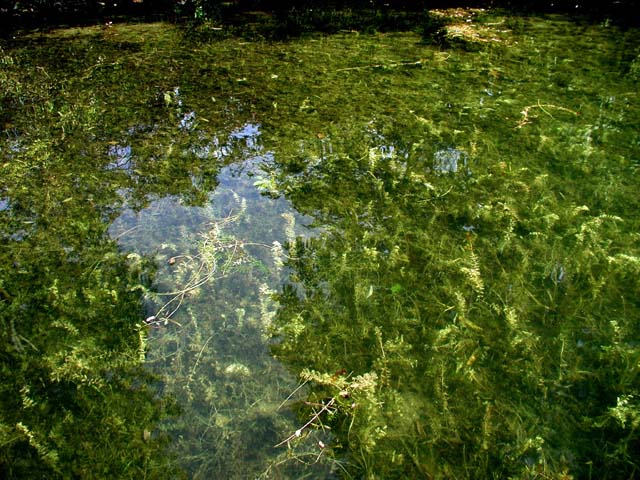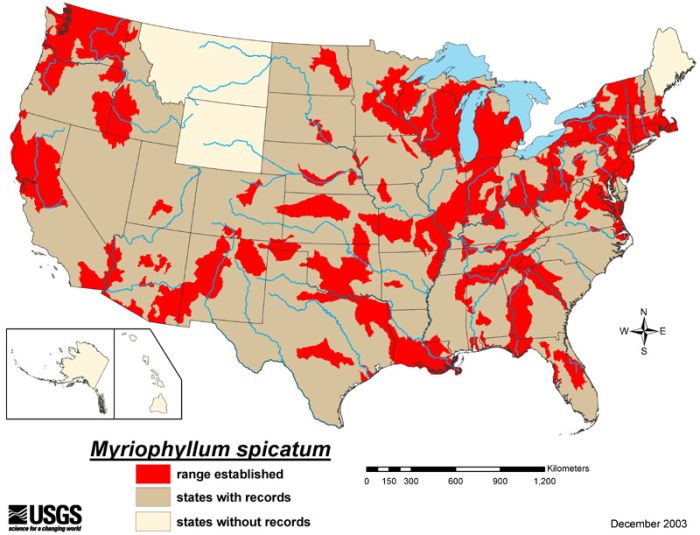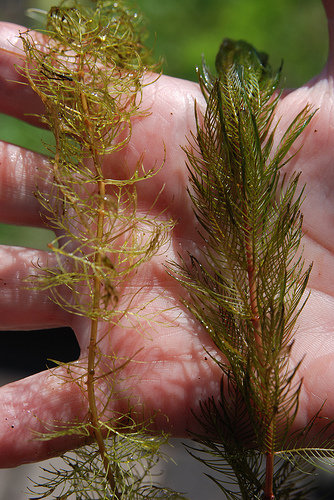Worst Water Weeds: Eurasian Watermilfoil
Commonly called Eurasian Watermilfoil or Spiked Watermilfoil, this invasive exotic water weed is becoming as widespread and as troublesome as Hydrilla. It’s on the list of 79 different invasive and exotic aquatic plants maintained by the Center for Invasive Species and Ecosystem Health. Although its feathery appearance is attractive, the Aquatic Nuisance Species Task Force, a joint effort of the US Fish & Wildlife Service and the National Oceanic and Atmospheric Administration, calls it “a highly invasive and aggressive species.”
Scientific Name: Myriophyllum spicatum.
Origins: The first recorded instances of Eurasian Watermilfoil date back to the 1940s, but it’s likely to have been introduced to North America even earlier than that, as far back as the 1880s. Like Hydrilla, it was once a common plant to purchase for aquariums. It is native to Europe, Asia and North Africa.
Habitats: This submersed aquatic plant is rooted and its stems extend up to the water surface, typically reaching 3-10 feet in length but can grow as long as 30 feet. It can be found in lakes, reservoirs, ponds, ditches, streams, small rivers and even the brackish waters of estuaries and bays. Similar to Hydrilla, it can form dense tangles of stems underwater and thick mats at the surface and also can reproduce from its own small fragments, which is why it has been able to spread throughout the nation.


Eco-Impacts: Eurasian Watermilfoil can greatly alter the aquatic ecosystems where it takes root. The thick mats can prevent recreational uses (boating, fishing, swimming). It can interfere with irrigation and power generation by blocking water intakes. It can block needed oxygenation when the thick mats prevent the flow of oxygenated surface waters to deeper water. It also increases rates of sedimentation by keeping sediments trapped. Because it starts its spring growth earlier than native species, Eurasian Watermilfoil shades them out, decreasing aquatic plant diversity.
Correctly Identifying Eurasian Watermilfoil

Weedoo’s TC 3000 series® Work Boat unloading into Lake Balboa
(Photo credit: Jeff Meek Photos)
One of the problems with Watermilfoil is that there are native non-invasive species you want to protect, the main one of which is Northern Watermilfoil. According to Brant Lake Milfoil Control, “It can be distinguished by the number of leaf divisions; Eurasian milfoil has 9-21 pairs of leaflets per leaf, while Northern milfoil typically has 7-11 pairs of leaflets. Another technique for telling the two apart is that the feathery leaves of Eurasian milfoil collapse when removed from the water, while Northern Milfoil leaves remain firm. The photograph shows the difference (Northern Watermilfoil is on the left, Eurasian Watermilfoil is on the right).
Eurasian Watermilfoil Removal with Weedoo Environmental Work Boats
Chemical herbicides used on ponds, lakes, rivers or reservoirs to get rid of Eurasian Watermilfoil is rarely a good idea, which is why many infestations have been tackled by manual or mechanical removal. Doing it by hand takes a lot of volunteer labor and is incredibly time-consuming. If you’re facing a serious Eurasian Watermilfoil infestation, this is when you want to consider a Weedoo Work Boat such as our AquaHarvester.
Fiberglass/Kevlar® construction includes Weedoo 170-Conveyor/Harvesting System with detachable bag collection assembly and Weedoo T-1305 DOT-approved highway boat trailer. The factory-installed 24-Volt PowerPack includes a lithium/solar battery system that runs all day without burning fossil fuels and includes on-board marine charger and captain helm assembly. Available in single motor or twin Torqeedo outdrives mounted on Weedoo Power Trim-N-Tilt system.
Ready to tackle those wily water weeds without chemicals? Contact Weedoo today!
